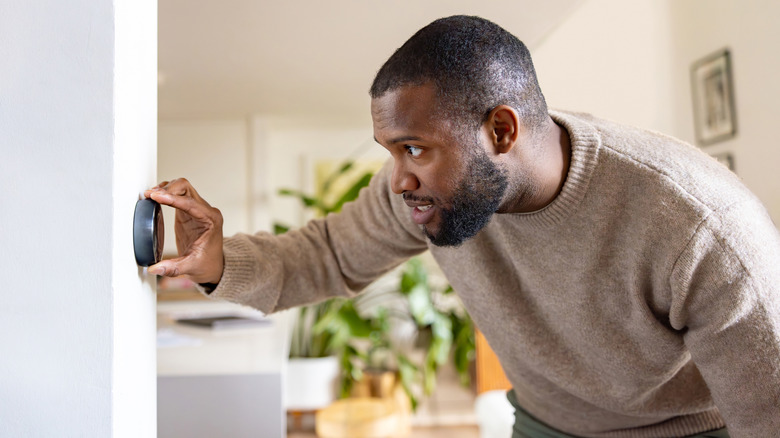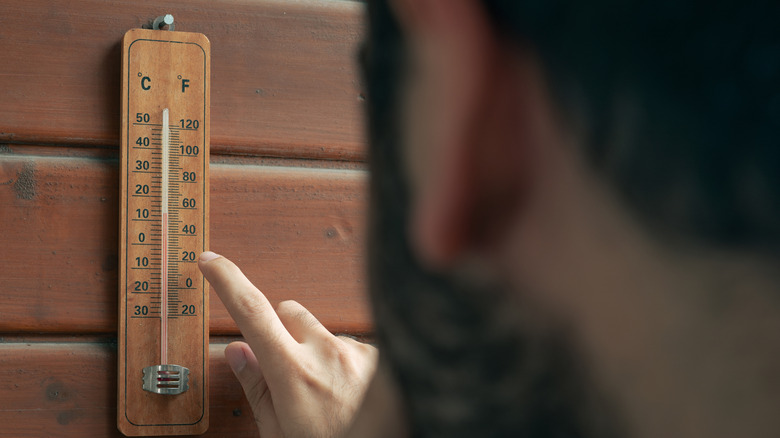When's The Best Time To Turn On Your Heat? Here's What You Need To Know
With home heating costs projected to increase, you certainly don't want your heater to run unnecessarily. But turning on your heat either too early or too late in the season can bring up problems outside of increased utility bills. In fact, not running your heater (or running it too soon) can actually decrease the lifespan of your overall HVAC system and lead to more costly issues in the long-run. While the decision of exactly when to turn on the heat is nuanced, most experts recommend running your heater once the outdoor air temperatures are below 60 degrees Fahrenheit for several days in a row.
Before you determine the best time to turn on your heater, it's important to investigate whether the device can handle this type of increased usage during the winter months. Getting an HVAC inspection before temperatures drop is a good idea to ensure any issues are caught in advance. The last thing you want to encounter on a cold day is a malfunctioning heater, so you'll want to determine if you're getting your furnace inspected at the right time of year. It's also important to keep changing your air filters at least once every few months to ensure the heater doesn't get overworked and use more energy than it should. By following these key maintenance steps, your heater will be ready to use as soon as you're ready to turn it on.
Consistently cool temperatures are key to knowing when it's time to run the heater
While you might experience some up and down weather in your area ahead of the winter season, you should be prepared to run your heater once outdoor temperatures consistently stay in the 50 degree Fahrenheit range and below. These air temperatures are cold enough to make the inside of your home feel uncomfortably chilly. Also, temperatures below 50 degrees may cause problems with bursting pipes. Deciding on when to turn on your heater also depends on how cold it is inside your house. This can be variable, but some people find that running the heater may be necessary once indoor temps fall below 64 degrees.
Also, if you don't have one already, consider pairing your HVAC system with a programmable thermostat. Set the ideal temperature you want for both heating and cooling so that the system will automatically turn on when indoor temperatures fall out of this range. In the case of the heater, you may want to set the thermostat to run once the indoor temperature reaches 64 degrees. You can also set these by time so that the system doesn't run as much when no one is home. This can take the guesswork of having to constantly keep tabs on indoor and outdoor temperature fluctuations. Upgrading to a programmable thermostat can make the temperatures in your home more consistent so you can stay warm while also reducing your overall energy output.
Simply feeling cold is another sign you need to turn on the heat
Paying attention to both indoor and outdoor temperatures is a good way to know when to run the heater, but it's also helpful to tune into how cold it actually feels in your home. Cozying up with a jacket, sweater, or blanket is normal for the colder months. If you still feel cold though, this could be a sign that you need the heater on. This is especially the case if it's cold inside your home during the daytime hours. Tile or hard flooring that feels cold to the touch is yet another sign you might need to run the heater. It's also worth being on the lookout for places in your home that may be letting the cold air in.
Finally, the decision of when to turn on the heat can be based on your own temperature preferences, as well as the current needs of your household. Some people naturally run colder than others and need to turn the heat on a bit sooner in the season. Other households may have older adults or young children who may need more heat, too. You may even need the help of the heat if you're feeling under the weather and are battling chills.


